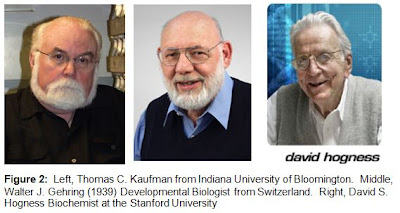I think it
is important to recognize scientists who made important contributions to
science, in whatever field and in whatever time they made their
discoveries. Here I would like to talk
about the significance of the discovery of the homeobox genes. Several scientists contributed significant
work to that milestone in evolutionary and developmental biology. After fertilizing an egg, cells divide
gradually until it forms tissues like skin, muscle, nerves and others. However, before cells begin to specialize,
the body begins to designate mayor regions like head, trunk and tail. The first scientist discovering the head to
tail or the determination of
the anteroposterior axis was Ross G. Harrison of the Yale University. In 1918 Harrison showed that when he took embryonic cells from an amphibian from a certain region in neural stage and transplanted them to another embryo, this one formed an extra forelimb or extremity. His conclusion was that these cells already knew what to do in whatever place they were. He initiated the era of cell transplantation experiments. After World War II scientists changed from transplantation experiments to genetic studies of how the body took shape. In 1948 Edward B. Lewis of the California Institute of Technology started to analyze homeotic mutations in the fruit fly Drosophila melanogaster. By mutating homeotic genes some body parts are replace with other structures from other body parts. Examples are the bithorax mutant that has two pairs of wings and not just one pair as usual, or the antennapedia mutant that has legs instead of antenna in the head. Lewis found that the mutated genes were mayor players in the body formation. But it was not until 1980’s that scientist could isolate specific genes so they could study them.

the anteroposterior axis was Ross G. Harrison of the Yale University. In 1918 Harrison showed that when he took embryonic cells from an amphibian from a certain region in neural stage and transplanted them to another embryo, this one formed an extra forelimb or extremity. His conclusion was that these cells already knew what to do in whatever place they were. He initiated the era of cell transplantation experiments. After World War II scientists changed from transplantation experiments to genetic studies of how the body took shape. In 1948 Edward B. Lewis of the California Institute of Technology started to analyze homeotic mutations in the fruit fly Drosophila melanogaster. By mutating homeotic genes some body parts are replace with other structures from other body parts. Examples are the bithorax mutant that has two pairs of wings and not just one pair as usual, or the antennapedia mutant that has legs instead of antenna in the head. Lewis found that the mutated genes were mayor players in the body formation. But it was not until 1980’s that scientist could isolate specific genes so they could study them.

David S. Hogness and Welcome Bender of the
Stanford University were the first to isolate the genes Ultrabithorax, Abdominal A and
Abdominal B and the Bitorax complex. At the same time Walter J. Gehring and
Richard L. Garber of the University of Basel and Thomas C. Kaufman of the Indiana University isolated
genes like Antennapedia, Labial,
Proboscapedia, Deformed and Antennapedia. All this work was done in fruit flies, but
scientists became more interested in finding a similar pattern in a vertebrate
model organism.
Even there has been done significant genetic work on mice, there was no such comparable homeotic gene
found like the ones in drosophila. It
was the time when Eddy M. De Robertis, Guillermo Oliver and Christopher V. E.
Wright had this weird idea to us the
homeobox probes that McGinnis and Gehring used in the fruit fly.However they had not much support from the
other scientists because at that time no one believed that two such different
species like fruit flies and frogs could have genes in common. Nevertheless they made the experiment and
found a surprise; in frog exists also a homeobox region that seems to control
vertebrate development. This is an
example how different animal models and different strategies can help revel
important discoveries in science as in this case in evo devo research. Therefore it is important to mention new knowledge;
however it is also important to mention the people behind these important
discoveries.Reference:
- E. M. De Robertis, G. Oliver, C. V. E. Wright, 1990. Homeobox genes and the vertebrate body plan. Scientific american.


No hay comentarios:
Publicar un comentario